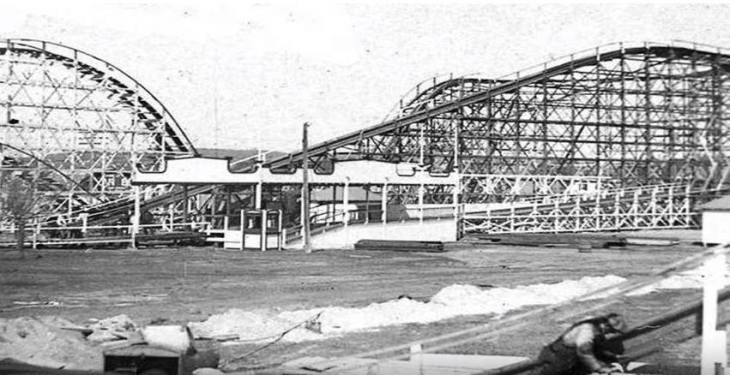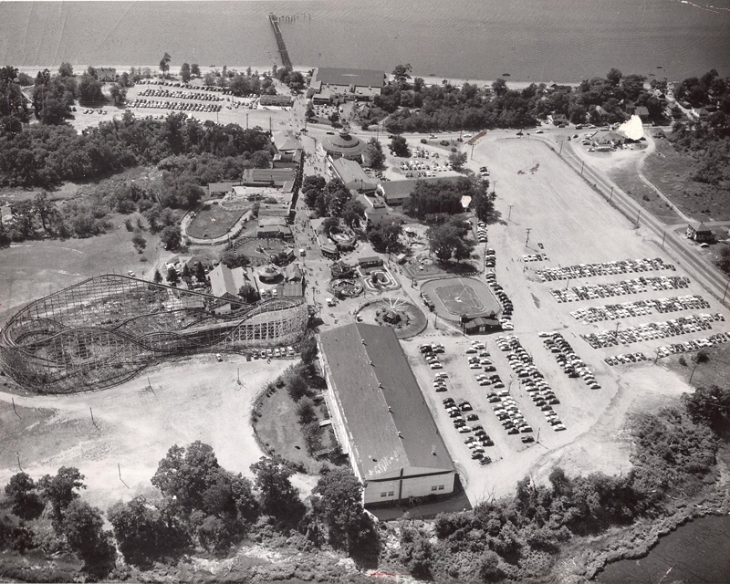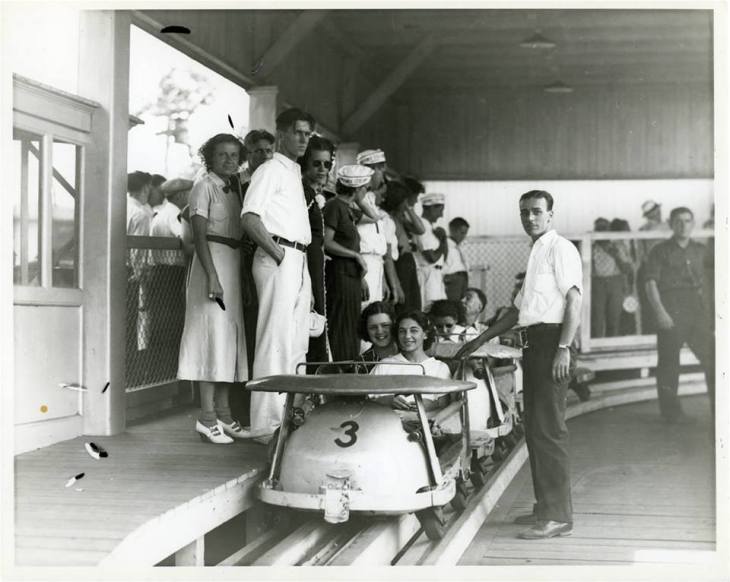The hurricane of 1938 wiped out four of Rhode Island’s wooden roller coasters, eliminating the artistry of some of the world’s most prolific ride designers.

What do the Bullet, the Comet, the Wildcat and the Cyclone all have in common? All met their fate to the September 21, 1938 hurricane that crippled New England. It is estimated that the hurricane killed 682 people, damaged or destroyed more than 57,000 homes, and caused property losses estimated at $306 million. While some winters have been brutal to we southern New Englanders with its power outages, school cancellations, and property damage; consider what happened decades ago one late summer day.
The 1938 storm not only destroyed most of Rhode Island’s coasters; it leveled two in nearby Massachusetts, at Fall River’s Sandy Beach Park and New Bedford’s Acushnet Park. Today’s blog post focuses on the Ocean State coaster casualties.
Island Park, Portsmouth
According to roller coaster researcher Patrick McKinney, the Bullet was installed here in 1926 by legendary builder Harry C. Baker as seen in this 1/23/1926 Billboard magazine article.

After two short years, a windstorm did heavy damage to the coaster which would receive alternations in its profile for its 1929 reopening. The 1938 storm sealed its fate. Below are some photos courtesy of John T. Pierce.



To read more about Island Park, go to: https://www.facebook.com/IntheDayRI/posts/929712583802924
Easton’s Beach, Newport
Fred Church left the prestigious ride design company of Prior & Church in 1928 to set out with his own coaster creations, and he drafted a beauty by the beach in 1931. By all accounts it was one of his famous Bobs-style coasters, and it was named the Cyclone. It was a seaside sensation that saw its untimely demise seven years later. Below are some images, courtesy of H.H. Harris, the Newport Historical Society, and John Carothers.



To read more about Easton’s Beach, go to: https://www.facebook.com/RhodeIslandRuins/posts/793953490741607
Crescent Park, East Providence
Harry C. Baker was a gifted ride builder who also managed the former Rexford Park (1906-1933) in Schenectady, New York. With his headquarters at the park, he did most of his coaster and funhouse building on the East Coast. In 1928 he was commissioned by Crescent Park to build the Comet coaster at the far end of the park near the Alhambra Ballroom. Baker’s coaster received extensive damage by the 1938 hurricane.


In the months that followed, Crescent Park ownership hired East Providence’s Ed Leis to reconstruct it with a completely different profile, and it was renamed the Zephyr.

Now, let’s compare the Baker coaster to the Leis coaster.
Below is Baker’s 1920s Comet.

And below is the Leis’ Zephyr which operated 1939 to 1961. Note the different profiles between the two coasters. All Crescent Park photos here are courtesy of Ed Serowik.

To read more about Crescent Park, go to:
https://www.facebook.com/RhodeIslandRuins/posts/740114126125544
http://laffinthedark.com/articles/CP/cp_1.htm
Rocky Point Park, Warwick
Two incredible roller coasters, the Wildcat and Flying Turns. The Wildcat, designed by Herbert Schmeck of the Philadelphia Toboggan Company (PTC) for the 1926 season, was no match for the high winds of 1938 storm.
Here’s the Wildcat ascending its 77-foot lift hill.

And the Flying Turns (below) Both photos courtesy of John Carothers.
The Flying Turns, installed in 1931 by PTC, was not completely destroyed by the hurricane and since it was operating on a ten-year lease with PTC, the coaster was repaired and actually operated until the lease expired in 1941, amid the shuttered park. The coaster was close to the main park entrance, hence making it doable. Rocky Point didn’t reopen as whole until 1948.

Two rare photos of Rocky Point’s Flying Turns coaster. (1931 to 1938)
(Image credit: Charles J. Jacques, Jr.)


Here’s the Wildcat under construction in 1926, courtesy of talesofrockypointpark.com.

You can read more about these two PTC coasters at these two links:
https://amusementparksandbeyond.wordpress.com/2017/11/28/short-turns-at-rocky-point-park/
https://amusementparksandbeyond.wordpress.com/2017/10/18/the-wildcat-strike-at-rocky-point
So, had there not been the 1938 hurricane, do you think these coasters…these parks…would still be operation today? Something to think about, for sure.

 To see what’s happen on the grounds of Rocky Point these days go to:
To see what’s happen on the grounds of Rocky Point these days go to:

Great article, George! Interesting to see some of these photos for the first time. With a 77-foot lift hill, the first Wildcat must have been an impressive coaster.
LikeLiked by 1 person
Thanks John!
LikeLike
I hate to sound like a nag to you, but there are two rides listed here which appear to have major inconsistencies in their attributions:
The first is ‘The Bullet’ of Island Park, 1926. This is not likely a Prior & Church coaster as several sources appear to credit Harry C. Baker, Inc. with its creation instead, as follows:
I – In the January 23, 1926 issue of Billboard in an article on page70 ‘Business outlook bright says Baker’ states; “In talking with a Billboard representative recently Baker announced he had signed a contract with the Island Park Amusement Company, Newburyport Mass., for the construction of a mammoth coaster at Island Park, Portsmouth R.I. This ride will be an ultra-sensational one and the construction of It will start within the next few days”. (note: this page can be viewed online at site ‘fultonhistory.com’. I tried linking the specific archived page but the address was too long)
Other articles detail the early history of rebuilding the coaster suffered after being wrecked in a storm post-1927 season, and then rebuilt again after fire burned much of the coaster down before the 1928 opening. Both of these rebuilds appear to also have been handled by Baker, Inc.
II: Robert Cartmell’s book ‘The Incredible Scream Machine’, page165, features an attempt by Joe Heflin to list all Traver, Prior and Church roller coasters, but the list appears to slip into mostly unrelated coasters in its second half, rambling through various late-20s coasters by John A Miller Co., Philadelphia Toboggan Co, Vettel, and Harry C Baker Inc., among others. This is most likely a section erratically included by heflin from a seperate list or lists and does not entirely represent Traver or P&C associated coaster, otherwise why would it note several rides in this section as by Traver and the others with other designers named next to them?
The Island Park, Portsmouth ride appears on the list as follows: “Island Park, Portsmouth, Rhode Island (Harry Baker)”.
III: I copied an attribution to Baker from incoasterpaedia (c.2000s) though it was probably from one of the above sources.
Also for what its worth, I’ve been requesting information from Jim Abbate of NAPHA on a somewhat unrelated matter and am presently awaiting data from the plan of this coaster which apparently survives in NAPHA’s archives. Its presence there suggests the ride was first drawn up in late 1925 under Miller & Baker, Inc. before that firm yielded to Harry C. Baker, Inc. for the 1926 season (It will take forever to explain that Miller & Baker didnt dissolve in 1923 but suffice it to say I can show this through several channels – the firm existed but the business relationship was degrading).
The Heflin list may explain where the attribution to Prior & Church presently given by the RCDB comes from, but there is no explanation for the erratic appearence of that section of Heflin’s list, and the RCDB is not always reliable in what they post.
The second ride is the ‘Zephyr’ of Crescent Park, which is (like the Bullet) a Harry C. Baker, Inc. coaster, but which was built for the 1928 season. Several contemporary Billboard articles note its conception and the original ride specs ‘as built’. The ride was conceived as the ‘Whippet Coaster’ on the drawing boards but ultimately opened under the name ‘Lightning’ for 1928. The design itself is similar in character to two other Baker, Inc. rides from that season: ‘Cyclone’, of Nolan’s Point Park, Lake Hopatcong, N.J.; and ‘Whippet’, of Columbia Park, North Bergen, N.J. -both of which are to designs by the company’s Cheif Engineer, Vernon Keenan.
LikeLike
Well, yeah, but the Island Park ride situation is probably more important. I have yet to see anything in contemporary sources that points to Prior & Church being involved with the Island Park ride. The only sources I’ve seen which associate this ride with them are the RCDB and (sort of) the above-mentioned Joe Heflin list, which, as I said, offers no explanation of how most of the rides in the second half relate to P&C or Traver, it just looks like they were randomly dumped in the list as an afterthought, or because he wasn’t sure or something.
I think it highly unlikely that P&C/Traver had anything to do with most of the involved rides in that section, especially as they were all from competing firms which would have been cautious to not become reliant on their main adversary to supply parts for them, much less design whole coasters for them.
There does apear to be one oddity though with the all-new 1928 Baker, Inc. rides, in that they appear to be using P.T.Co. rolling stock AND patented track construction, and I’m a little mistified as to how P.T.Co. could have permitted this without gouging Baker, Inc. through royalty charges.
LikeLike
Thanks for the info. As for Crescent Park, I’m aware that there are discrepancies as to the actual install year during the 1920s and the actual name of the Baker coaster. Some old-timers in my home city referred to it as the Comet but I once saw an old Providence Journal article referring to it as Lightning. I’ve yet to see a facade photo of this coaster; only the overhead shot I included here. I just amended this blog post to include photos of the storm damaged Baker coaster and its 1939 replacement by Leis as the Zephyr…the later coaster’s facade. BTW – I rode the Zephyr in 1960 and 1961 at age six and seven.
LikeLike
I know, the Crescent Park ride was from 28 not 22.
But as I said, I dont think the present Island Park ‘Bullet’ attributions are on solid ground. Unless someone has solid data from a contemporary source for Prior & Church’s involvement with the ride, I’m inclined to distrust the claim in favor of what I’ve actually read in the contemporary sources of the time.
LikeLike
PS: I’m having issues approving comments and submitting my own with my phone this evening so I may have accidentally deleted one of your responses. If so, I apologize.
LikeLike
Its OK
I just wanted to make sure it was understood that Its the BULLET of ISLAND PARK Im most concerned with as there does not appear to be any contemporary source (i.e. a source from the time of the ride’s creation) to back up the claim that it is Prior & Church coaster.
I may have found another possible source for this claim, but from the near-present day. Someone apparently said they spotted a ‘center board construction’ (????) on part of the ride and thereby insisted it was a P&C ride – if this is where the P&C attribution comes from, and if this is what passes for historical accuracy we are in deep you-know-what.
I admit, I myself have postulated designer attributions before by studying the ride construction and design character, but now I try to make sure this is noted only as a ‘best guess’ as this method has led to the wrong conclusion many times, even if sometimes it proves right.
In any case, a solid source from the time is needed before the Island Park ride is needed before it can be said that the ride is by Prior & Church, but at present we only really have Billboard of January 23, 1926 saying that the ride is from Harry C Baker, and so that is what should be said of it unless someone can produce a better source.
LikeLike
Very nice. Too bad they didn’t love these parks like we do.
LikeLike
George/ Thanks for the nice piece and for Patrick, Richard Munch’s 1991 Roller Coaster Directory had the Bullet by Baker being built in 921 or 22.
LikeLike
My mother sent me a photo of my grandparents in 1928 sitting in front of what she thought was a bridge. I recognized it as a coaster and matched it up to the bullet thanks to your page. Thanks
LikeLike